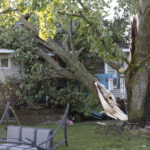We think the time is right for you all to explore the [Florida] flood insurance market.”
That was the message Florida Senator Jeff Brandes gave insurance industry attendees at the first ever Florida Flood Insurance Conference on Dec. 9 in St. Petersburg.
Brandes added that lawmakers are doing what they can to make the Florida flood market attractive and accommodating to private insurers.
“Our goal is to have 10 private insurers or more in Florida selling flood insurance in the next 24 months, and with your help we think we are going to get there,” Brandes said.
The Florida flood insurance market has become an expensive problem for homeowners, and it’s getting more expensive every year, according to lawmakers including Brandes and Florida Insurance Commissioner Kevin McCarty.
Brandes, a Republican, represents District 22 of Florida that includes Pinellas and Hillsborough counties. He has been leading the charge among Florida lawmakers to change Florida’s approach to flood insurance.
The state currently requires residents in high-risk flood areas with a mortgage from a federally regulated or insured lender to purchase flood insurance from either the National Flood Insurance Program (NFIP) or a private flood insurer. Currently Florida accounts for 37 percent of the NFIP’s policies but, McCarty told Insurance Journal, Florida has paid out “far more than what we have gotten in return” and that Florida is paying “disproportionately higher rates” compared to the rest of the country.
Brandes said his efforts to tackle this problem began when he was elected in 2010 and his constituents were faced with dramatic increases to flood insurance rates as a result of the Biggert-Waters Flood Insurance Act, which aimed to reform the program.
“I was really thrust into this area by seeing homeowners who couldn’t sell their homes or real estate agents who, instead of putting ‘pool’ on top of the for-sale sign put ‘No Flood Insurance Required,’ because nothing was being sold under Biggert-Waters, when the rates went up so dramatically,” Brandes said.
The state enacted legislation in 2014 designed to streamline the process for private insurers to write flood insurance to encourage more flood insurance competition. A handful of private flood insurance markets have entered the state since then on a primary basis.
Brandes has introduced another bill for the upcoming session that would create a flood mitigation and assistance program, which he said would further encourage the private insurance market.
“We want to create the most fertile ground for any admitted carrier or insurance company to do business in the state of Florida in the flood insurance space,” Brandes said.
Brandes and McCarty have also been working together to address the Florida flood insurance rate issue since this past summer when Brandes asked the insurance commissioner to look into the NFIP’s ratemaking practices.
McCarty had previously called out the NFIP’s rates in Florida as “unfairly discriminatory.” He requested the ratemaking data from the Federal Emergency Management Agency, which manages the NFIP, to analyze it through Florida law and asked FEMA to respond by Dec. 15. McCarty has not yet received the data but his office believes FEMA is cooperating. On Dec. 16, the Florida Office of Insurance Regulation issued the following statement to Insurance Journal:
“The Office has not yet received a formal written response from FEMA. However, the Commissioner has been in discussions with officials at the NFIP. They have expressed a willingness to cooperate with the request and have given their assurances that they want to work collaboratively with the Office to provide what information they can. We know that we have asked them for a significant amount of technical actuarial data, so we understand more time may be needed for a complete response. Overall, we are very encouraged by these discussions and look forward to working with them further on this important issue.”
Flood Summit
The Flood Insurance Conference, Brandes said, was an opportunity to meet with the insurance industry face-to-face and discuss findings of a Guy Carpenter “Flood Insurance Risk Study” conducted for FEMA of the NFIP. Brandes said the report had not previously been shared publicly.
“We simply said ‘Come to Florida, let’s get some reinsurers and some analytics teams together and let’s have a conversation about flood insurance in Florida,'” he said.
Presenters at the summit included: Bryan Koon, director of Florida’s Division of Emergency Management; Maria Wells, of the Florida Realtors Association and the National Association of Realtors; Commissioner McCarty; Jake Clark and Tim Gardner of Guy Carpenter; and representatives from reinsurers such as Swiss Re and modeling and technology firms Weather Analytics and Torrent Technology.
Jake Clark, managing director of Guy Carpenter, talked about the FEMA Flood Risk Study’s three components – reinsurance study; privatization study; and supporting analytics.
Clark said the company is currently doing additional work for FEMA looking at reinsuring the NFIP, as well as gathering info for FEMA to present to lawmakers when the program is up for renewal in 2017.
Clark highlighted Florida’s risk and cost to the NFIP program thus far and reemphasized the opportunities available to insurers.
“On one level, clearly the modeling suggests that the loss potential for flood-related portfolios can be a lot larger than what history might suggest,” Clark said. “Yet at the same token, if you look at the figures in totality at the 1-in-100-year level and the 1-in-250-year level, we would argue there is plenty of room – and plenty of appetite – for the industry to play a much bigger role in managing this portfolio.”
John Auer, president and CEO of Florida-based American Strategic Insurance, attended the summit.
His company started off as a writer of excess flood and recently rolled out a private flood insurance product to its homeowners insurance clients in Florida. He said his company will succeed as a private market by being selective about where it offers coverage. The company is also taking a “cautious stance” by only writing homes that are 2,500 feet away from water on the West coast of Florida and 1,000 feet away on the East coast of the state.
“We don’t want to write it everywhere. If we can stick to lower risk areas and can write a rate that is lower or similar to the NFIP, we will do it,” Auer said.
He said Florida currently has a low flood loss ratio, but the state is still at an extreme flood risk and insurers have to understand and be responsible in how they cover the state.
“We are really only one major event away from those numbers reversing themselves, but when that will happen, who knows?” he said. “But one thing I will say for certain is the [NFIP] rates don’t make a lot of sense from one place to another, and that’s why we will write places we think we can sell and be profitable.”
Topics Trends Carriers Florida Legislation Flood Reinsurance Market FEMA
Was this article valuable?
Here are more articles you may enjoy.


 Trump Administration Turning to Private Firms in Cyber Offensive
Trump Administration Turning to Private Firms in Cyber Offensive  One of Highest Property Claims Severity Recorded in Q3 on Low Volume, Says Verisk
One of Highest Property Claims Severity Recorded in Q3 on Low Volume, Says Verisk  Acrisure to Buy MGA Vave From Canopius
Acrisure to Buy MGA Vave From Canopius  Chubb, The Hartford, Liberty and Travelers Team Up on Surety Tech Launch
Chubb, The Hartford, Liberty and Travelers Team Up on Surety Tech Launch 


